CUTTING AND BITTING TEETH
INTRODUCTION:-
Teeth are the hardest non- bony structure in the vertebrate body, jaw bones attach with these
in cutting and biting teeth. In our body, we use these for biting, chewing and
grinding of the food or in catching of prey in cutting and biting teeth. We intake food with the help of teeth.
TYPES OF TEETH IN CUTTING AND BITING TEETH::–
Most animals have Teeth in their jaws. Teeth are used to cut and break
the food into smaller parts. The kind, number and arrangement of teeth
in a personal or animal we term it as ” dentition “. It is of two types:
a) HOMODONT: All the teeth in the jaws are similar in shape and structure e.g fish and frog.
b)HETERODONT: The teeth in the jaws are not similar in shape and
structure e.g. cows and humans.
Mammals have heterodont dentition since all the teeth are not alike in them .
There are four types of teeth in mammals; incisors, canines, premolars and molars.
The number, size and shape of the teeth depends on the food the animals consume.
STRUCTURE OF A HUMAN TOOTH IN CUTTING AND BITING TEETH::–
The Bony sockets or alveoli in the jaw bones encloses the human teeth.
These we term as ” thecodont”. Each tooth consists of three parts.
* ROOTS— The basal part, embedded in the alveoli.
* NECK— They middle part enclosed in the gum.
* CROWN— They visible part projected beyond the gum.
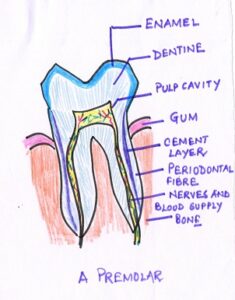
Fig#1 simplified diagram of a premolar
In longitudinal section of a tooth in cutting and biting teeth, the following parts are seen:-
a) Enamel:
The white shiny outer covering of the crown is called enamel or ivory.
Ø It is the hardest substance in the body. It can withstand tremendous pressure
while eating. Enamel wears away with age and dentine in cutting and biting teeth and there are exposed teeth. The
teeth start looking yellow.
b) Dentine: It is the yellowish bone- like tissue that lies inside the enamel.
Dentine is not hard like enamel but harder and stronger than a bone.
c) Cement:
It is a bone like structure that covers and fixes the root of
tooth in cutting and biting teeth within the socket of bone.
d) Pulp cavity and pulp
: Pulp cavity is the central space in the tooth and is filled with soft
connective tissue. The pulp is richly supplied with blood capillaries, nerve fibers and
lymph vessels. These enter the pulp through root canal. The narrow part of the pulp
cavity in cutting and biting teeth is called root canal.
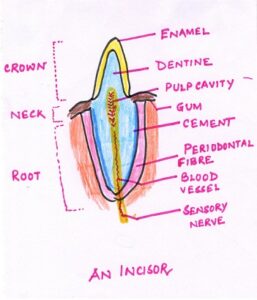
Fig#2 simplified diagram of an incisor
e) Odontoblasts: Dentine contains many canals in cutting and biting teeth having dentine producing cells we term as
Odontoblasts.
f) Periodontal fibres: Many fibres connect cement at one end and the jawbone at the other
end and hold the tooth firmly in position which are known as periodontal fiber.
CHARACTERISTICS OF HUMAN TEETH IN CUTTING AND BITING TEETH::
The human teeth are;
a) THECODONT—The socket of jaw bones contains the teeth.
b) DIPHYODONT: In human, we get two sets of teeth during lifetime.
These we know as temporary or deciduous teeth and permanent teeth.
The temporary teeth appear first. Permanent set of teeth replaces the milk teeth.
The deciduous or milk teeth fall because their roots begin to dissolve making way for
permanent teeth. The total number of teeth in adult is 32 which are permanent, but children
up to age of 12 years have just 20 temporary or milk teeth in cutting and biting teeth.
| The milk teeth start erupting out of the gums when the child is about 6-8 months old.The entire set of 20 milk teeth is completed by the age of two years. They start falling
out one by one at the age of 7-8 years and are replaced by permanent teeth by the age
of 12 years.
c) HETERODONT:
Different types of teeth to perform different functions. Based on
their functions they are of four types:
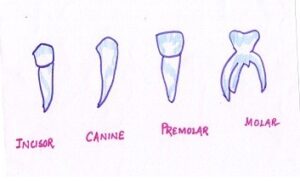
Fig#3 different types of teeth
b) INCISORS:
We can find these set of teeth at the front of the buccal cavity. They are flat and
straight with sharp edges which we use as “cutting and biting teeth.
ii) CANINES:
On either side of the incisors in each jaw we see canines. These
are sharp and pointed for “holding
and tearing the food” in cutting and biting teeth
iii) PREMOLARS:
There are two premolars situated next to the canines. Each premolar possesses one or two roots and two cups or projections on the surface of a tooth.
The premolars are specialized for ” crushing and grinding the food” in cutting and biting teeth.
iv) MOLARS:
These are the last three teeth in each jaw. They have more than one root.
Molars in the upper jaw have three roots while those in the lower jaw have two roots.
Each molar has four or five cusps. These types of food helps in crushing and grinding
of hard part of the food..
The last molar of each side in each jaw is we also term as the wisdom teeth, because it appears
last, generally at the age of 17-20 years when the body reaches maturity. However, in some
people this tooth does not appear at all. But this does not mean they have no ” wisdom”.
DENTITION AS PER DIET:
On the feeding habits of animals we classify the dentition:
HERBIVORES IN CUTTING AND BITING TEETH::
Animals like sheep, cow and horse have teeth with broad ridged surfaces
that are suitable for grinding tough plant material. The incisors and canines in cutting and biting teeth are generally
modified for biting off pieces of vegetation.
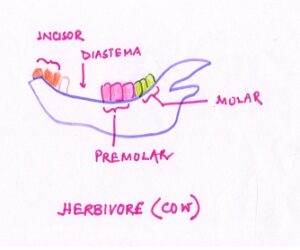
Fig#4 teeth structure of herbivore
CARNIVORES IN CUTTING AND BITING TEETH::
Animals like cat and dog have pointed incisors and canines they use to kill prey and tear off flesh. The premolars and molars are modified for crushing and shredding.

Fig#5 teeth structure of carnivore
OMNIVORES IN CUTTING AND BITING TEETH:
Animals such as human beings use to eat both vegetation and
meat and have a relatively mixed dentition. There are two incisors for cutting and biting teeth,
one canine for tearing, two premolars for grinding and three molars for crushing.
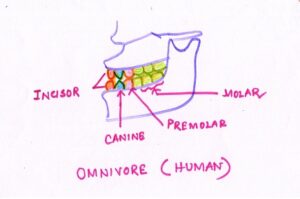
Fig#6 teeth structure of omnivore
DENTAL FORMULA
The number and arrangement of teeth in a mammal we represent as dental formula.
The number of teeth in right and left half of each jaw is the same in cutting and biting teeth. We represent the dental formula as
(Dental formula: number of teeth in one half of upper jaw÷ number of teeth in one half of lower
jaw) × 2
I+C+Pm+M
——————–. × 2/2
I+C+Pm+M
Here are some dental formula of various mammals including their dentition. ( TEETH- STRUCTURE AND FUNCTION)
a) Dental formula of cow ( herbivore)
0+0+3+3.
——————× 2/2= 12/18=30
3+1+2+3
Incisors are chisel-shaped. Sometimes canine is absent or less sharp. Vacant space between
incisors and premolars is called diastema.
b) Dental formula of dog ( carnivores)
3+1+4+2
——————×2/2 = 20/22= 42
3+1+4+3
Incisors are sharp for scraping flesh. Canines are long, curved and sharply pointed for tearing flesh in cutting and biting teeth. Premolars and molars have raised conical and pointed ridges or cups for shearing off flesh from bones
c) Dental formula of human being (omnivore)
2+1+2+3
————— × 2/2= 16/16 = 32
2+1+2+3
Incisors are chisel shaped and flat adapted for biting and cutting. Canines are short and blunt
used for holding the the food and tearing the fruits. Premolars and molars have low and blunt
crushing surfaces.
|
|
|
|





